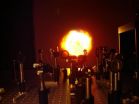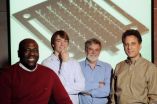(Press-News.org) Putnam Valley, NY. (Nov. 27, 2012) – A study published in the current issue of Cell Transplantation (21:8), now freely available on-line at http://www.ingentaconnect.com/content/cog/ct/, has found that when mesenchymal cells derived from skeletal muscle (SM-MSCs) or adipose tissue (ADSCs) were injected into the heart muscle (myocardium) of separate groups of laboratory rats that had suffered a myocardial infarction, rats in both groups experienced significantly improved left ventricle function and smaller infarct size after cell therapy.
The study, carried out by researchers at Oslo University Hospital and the Norwegian Center for Stem cell Research, Oslo University, sought to determine if MSCs from different organs would result in different functional outcomes.
"Despite advances in revascularization and medical therapy, acute myocardial infarction (AMI) and heart failure are still important causes of morbidity and mortality in industrialized countries," said study co-author Dr. Jan E. Brinchmann of the Norwegian center for Stem Cell Research at Oslo University Hospital, Oslo. "AMI leads to a permanent loss of contractile elements in the heart and the formation of fibrous scarring. Regeneration of contractile myocardium has been a target of cell therapy for more than a decade."
According to Dr. Brinchmann, MSCs tolerate hypoxia, secrete angiogenic factors and have been shown to improve vascularization; thus, they have properties suggesting that they may beneficially impact AMI, chronic heart failure and angina pectoris after cell transplantation.
Following injection into the "border zone" and infarct area of immunodeficient rats one week after induced myocardial infarction, the researchers used echocardiography to measure myocardial function and other analyses to measure the size of scaring, density of blood vessels in the scar, and the health of myocardial tissues.
"Our results showed that intramyocardial injection of both ADSCs and SM-MSCs one week after AMI led to a substantial decrease in infarct size and a significant improvement in left ventricle function when compared with injections of cell culture medium alone," concluded the authors. "There was a trend toward better functional improvement in the SM-MSC group when compared to the ADSC group, but this did not reach significance."
They concluded that many questions remain unanswered, including the question of whether MSCs isolated from different organisms could result in different functional outcomes. Other unanswered questions relate to the optimal time delay between the onset of myocardial infarction and injection of MSCs. These cells do, however, still appear to be "a potentially interesting adjuvant treatment modality for selected patients following acute myocardial infarction," they concluded.
###
Contact: Dr. Jan E. Brinchmann, Norwegian Center for Stem Cell Research, Institute of Basic Medical Sciences, Oslo University Hospital Rikshospitalet and University of Oslo, PO Box 1121 Blindern 0317 Oslo, Norway.
Tel. +42-22-84-04-89
Fax. +42-22- 85-10-58
Email: jan.brinchmann@rr.research.no
Citation: Beitnes, J. O.; Øie, E.; Shahdadfar, A.; Karlsen, T.; Müller, R. M. B.; Aakhus, S.; Reinholt, F. P.; Brinchmann, J. E. Intramyocardial Injections of Human Mesenchymal Stem Cells Following Acute Myocardial Infarction Modulate Scar Formation and Improve Left Ventricular Function. Cell Transplant. 21(8):1697-1709; 2012.
The Coeditor-in-chief's for CELL TRANSPLANTATION are at the Diabetes Research Institute, University of Miami Miller School of Medicine and Center for Neuropsychiatry, China Medical University Hospital, TaiChung, Taiwan. Contact, Camillo Ricordi, MD at ricordi@miami.edu or Shinn-Zong Lin, MD, PhD at shinnzong@yahoo.com.tw or David Eve, PhD at celltransplantation@gmail.com
News release by Florida Science Communications www.sciencescribe.net
Study suggests different organ-derived stem cell injections improve heart function
Both skeletal muscle MSCs and those from adipose tissues found to be effective
2012-11-27
ELSE PRESS RELEASES FROM THIS DATE:
Tracking pollution from outer space
2012-11-27
The thickest layers of global smog — caused by traffic, industry, and natural minerals, among other factors — are found over the world's megacities. But getting an accurate measurement of pollution is no easy task. On-the-ground monitoring stations do not always provide the most accurate picture —monitoring stations depend heavily on local positioning and some cities put stations in urban centers, while others build on the edge of a city.
Now Prof. Pinhas Alpert of Tel Aviv University's Department of Geophysics and Planetary Sciences and head of the Porter School of Environmental ...
Illuminating the no-man's land of waters' surface
2012-11-27
Water repelling molecules are said to be hydrophobic. The hydration – or formation of water interfaces around hydrophobic molecules – is important for many biological processes: protein folding, membrane formation, transport of proteins across an interface, the transmission of action potentials across membranes. It is involved as well in the process of creating mayonnaise, or in the fact that you can get rid of fat with soap. Hydrophobic interfaces although long studied, are poorly understood.
Here's an amusing kitchen-table experiment to illustrate waters unusual properties: ...
Measles vaccine given with a microneedle patch could boost immunization programs
2012-11-27
Measles vaccine given with painless and easy-to-administer microneedle patches can immunize against measles at least as well as vaccine given with conventional hypodermic needles, according to research done by the Georgia Institute of Technology and the Centers for Disease Control and Prevention (CDC).
In the study, the researchers developed a technique to dry and stabilize the measles vaccine – which depends on a live attenuated virus – and showed that it remained effective for at least 30 days after being placed onto the microneedles. They also demonstrated that the ...
Safer spinach? Scientist's technique dramatically reduces E. coli numbers
2012-11-27
URBANA – University of Illinois scientists have found a way to boost current industry capabilities when it comes to reducing the number of E. coli 0157:H7 cells that may live undetected on spinach leaves.
"By combining continuous ultrasound treatment with chlorine washing, we can reduce the total number of foodborne pathogenic bacteria by over 99.99 percent," said Hao Feng, a U of I professor of food science and human nutrition.
According to Feng, the USDA is looking for proposed technologies that can achieve a 4 to 6 log reduction in pathogen cells (a 6 log reduction ...
'Walking on marbles' could be a thing of the past for arthritis patients
2012-11-27
Researchers at the University of Southampton are to undertake a new stage of a study aimed at improving the health and mobility of those suffering from the common complaint of 'walking on marbles' associated with Rheumatoid Arthritis (RA) in the feet.
RA is the second most common form of arthritis in the UK, affecting almost 600,000 people, which results in the destruction of joints around the body caused by inflammation.
Forefeet often contain some of the first joints to be affected and those with the condition often say that they feel like they are 'walking on marbles'. ...
Seeing the world through the eyes of an Orangutan
2012-11-27
She is a captive bred Sumatran orangutan. He is a neuroscientist specialising in cognitive and sensory systems research. With the help of specially adapted eye tracking equipment they are hoping to explain some of the mysteries of the visual brain and improve the lives of captive bred animals.
Dr Neil Mennie, from The University of Nottingham Malaysia Campus (UNMC), has received funding from Ministry of Science and Technology and Innovation, Malaysia (MOSTI) to study the eye movements of Tsunami — a seven year old orangutan at The National Zoo of Malaysia (Zoo Negara). ...
Gene linked to respiratory distress in babies
2012-11-27
Some infants are more susceptible to potentially life-threatening breathing problems after birth, and rare, inherited DNA differences may explain why, according to research at Washington University School of Medicine in St. Louis.
The study is the first to identify a single gene — ABCA3 — that is associated with a significant number of cases of respiratory distress syndrome (RDS) in babies born at or near full term. RDS is the most common respiratory problem in newborns and the most common lung-related cause of death and disease among U.S. infants less than a year old.
Their ...
The installed price of solar photovoltaic systems in the US continues to decline at a rapid pace
2012-11-27
Berkeley, CA — The installed price of solar photovoltaic (PV) power systems in the United States fell substantially in 2011 and through the first half of 2012, according to the latest edition of Tracking the Sun, an annual PV cost-tracking report produced by the Department of Energy's Lawrence Berkeley National Laboratory (Berkeley Lab).
The median installed price of residential and commercial PV systems completed in 2011 fell by roughly 11 to 14 percent from the year before, depending on system size, and, in California, prices fell by an additional 3 to 7 percent within ...
Topical simvastatin shown to accelerate wound healing in diabetes
2012-11-27
Philadelphia, PA, November 27, 2012 – Delayed wound healing is a major complication of diabetes because the physiological changes in tissues and cells impair the wound healing process. This can result in additional disease outcomes such as diabetic foot ulcer, a significant cause of morbidity in the growing population of diabetic patients. A new study has found that topically applied simvastatin accelerates wound healing in diabetic mice, suggesting important implications for humans with diabetes. This study is published in the December issue of The American Journal of ...
Amyloid imaging helps in evaluating possible Alzheimer disease
2012-11-27
Philadelphia, Pa. (November 27, 2012) – A test to detect brain amyloid deposits associated with Alzheimer disease (AD) provides doctors with useful information on treatment and further testing for patients with cognitive impairment, according to a study published online by the journal Alzheimer Disease & Associated Disorders. The journal is published by Lippincott Williams & Wilkins, a part ofWolters Kluwer Health.
Positron emission tomography (PET) scans using a biomarker called florbetapir F18 can show amyloid plaques in the brain—a characteristic feature of AD. ...
LAST 30 PRESS RELEASES:
NASA’s Webb telescope finds bizarre atmosphere on a lemon-shaped exoplanet
The gut bacteria that put the brakes on weight gain in mice
Exploring how patients feel about AI transcription
Category ‘6’ tropical cyclone hot spots are growing
Video: Drivers struggle to multitask when using dashboard touch screens, study finds
SLU research shows surge in alcohol-related liver disease driving ‘deaths of despair’
Rising heat reshapes how microbes break down microplastics, new review finds
Roots reveal a hidden carbon pathway in maize plants
Membrane magic: FAMU-FSU researchers repurpose fuel cells membranes for new applications
UN Member States pledge to increase access to diagnosis and inhaled medicines for the 480 million people living with COPD
Combination therapy shows potential to treat pediatric brain cancer ATRT
Study links seabird nesting to shark turf wars in Hawai‘i
Legal sports betting linked to sharp increases in violent crime, study finds
Breakthrough AI from NYUAD speeds up discovery of life-supporting microbes
New Eva Mayr-Stihl Foundation funding initiative boosts research at University of Freiburg on adaptation of forests to global change
The perfect plastic? Plant-based, fully saltwater degradable, zero microplastics
Bias in data may be blocking AI’s potential to combat antibiotic resistance
Article-level metrics would provide more recognition to most researchers than journal-level metrics
Satiety’s little helper: Protein that supports appetite regulating protein identified
UF dives deep into predicting storm damage with computer models
A stormy ocean voyage yields insights on the global carbon cycle
Scientists identify first non-coding gene that controls cell size
Demonstration of altermagnetism in RuO₂ thin films -- A new magnetic material for the AI era
Penn researchers awarded $25M to conduct trial using smartphones to fight heart disease
PCORI awards funding for new patient-centered healthcare research
Exploring the origins of the universe: 145 low-noise amplifiers complete ALMA telescopes
Empress cicada wings help illuminate molecular structure
Using sound waves to detect helium
Time burden in patients with metastatic breast and ovarian cancer from clinic and home demands
Researchers discover bias in AI models that analyze pathology samples
[Press-News.org] Study suggests different organ-derived stem cell injections improve heart functionBoth skeletal muscle MSCs and those from adipose tissues found to be effective


